
In 2024, Rootjunky APK To Bypass Google FRP Lock For Honor X50 GT

Rootjunky APK To Bypass Google FRP Lock For Honor X50 GT
Factory Reset Protection (FRP) is a security feature built into Android devices running Android 5.1 Lollipop and later versions. It prevents someone from using your phone after a factory data reset without Google account login credentials. The FRP makes it much less attractive for thieves to steal Android phones, knowing they will need help to access them.
FRP automatically activates when you add a Google account to your Android phone. It links the Honor X50 GT device to your account, making it the “trusted owner.” Once activated, FRP becomes embedded in the phone’s system.
While Google FRP is a valuable security feature, it’s vital to acknowledge that there are legitimate situations where bypassing it might be necessary. These instances include forgotten Google account credentials, buying a second-hand device, and device issues. In these cases, tools like RootJunky can help you bypass FRP Lock. We’ll explore how to use RootJunky APK later, but first, let’s define what it is and its role in FRP bypass.

The RootJunky APK is a free Android application also called RootJunky SDL or RootJunky FRP Bypass tool. This app’s primary function is to bypass the Google Account FRP lock on Samsung devices. Rootjunky uses the weaknesses in Android’s setup process to create a new user account or switch existing ones, letting you bypass the FRP and regain control of your phone.
You can complete this process using the app by connecting your phone to a computer through an OTG cable. RootJunky can be helpfu l if you’ve forgotten your Google account password or bought a second-hand phone locked to someone else’s account. However, only use it if you have legitimate reasons to bypass FRP lock, like accessing your device after forgetting your Google account details.

Downloading the RootJunky FRP bypass tool from unofficial sources can introduce malware risks, so stick to trusted sources like the official website. Additionally, when exploring RootJunky, it is vital to keep the following in mind:
- Not all Android devices are susceptible to the methods used by RootJunky. It is necessary to check compatibility with your specific device model and Android version.
- Using FRP bypass tools like RootJunkycan potentially compromise the security of your device. Be cautious and proceed if you fully understand the risks involved.
- Bypassing FRP may involve data loss.
- Download RootJunky FRP bypass APK from a reliable source to minimize the risk of malware or viruses. You can check the APK file from official websites or trusted forums.
- Google constantly updates its security measures, so these tools may not always work effectively.
Part 2: How To Use RootJunky To Bypass Google FRP?
Here are the general steps to use the FRP Bypass APK RootJunky app to bypass Google FRP lock. But remember that specific steps may vary depending on your device and Android version:
- Step 1: On your computer, download the Rootjunky RealTerm program from the official Rootjunky website.

- Step 2: On your phone, download the Rootjunky APK (com.rootjunky.frpbypass-1.0.apk) file from the official website or other reputable sites.

- Step 3: Go to Settings > Security and tap Install unknown apps. Then, enable unknown sources to allow installation of apps from outside the Play Store. Connect your device to a Wi-Fi network.

- Step 4: On your Android phone, open a file explorer app and install the downloaded RootJunky APK file.
- Step 5: Connect your smartphone to your computer using a USB cable.
- Step 6: Launch the Rootjunky RealTerm program on your computer. Under the Display tab, check the Half Duplex option.
- Step 7: On your computer, go to Device Manager > Modems. Locate your device’s port name (e.g., COM3).
- Step 8: On the RealTerm program, enter the correct port number under the Ports tab, then click Change.

Step 9: Click Send to establish a connection. Enter the two commands:
at + creg? \ r \ n
atd1234; \ r \ n
Step 10: Once connected, the Rootjunky APK on your phone will provide on-screen instructions to bypass FRP.
Step 11: If prompted, perform a factory data reset of your device.
While RootJunky offers a free method for FRP bypass, it can be incompatible with your device’s brand, requiring technical knowledge, tedious, and potentially risky. If you are looking for a simpler, safer, and more user-friendly solution, Wondershare Dr.Fone might be a better fit for you. If you want to learn how to use this tool to bypass FRP lock with minimal technical expertise, then keep reading.
Part 3: Easier Tool Than RootJunky APK To Bypass Google FRP
Google FRP adds an extra layer of security after a device reset. However, regaining access to the smartphone can be challenging if you forget your Google account details, forget your lock screen, or just buy a used device. While methods like the FRP RootJunky app exist, using it can be complex or risky.
Consider exploring third-party options like Dr.Fone for a potentially easier and safer FRP bypass solution. Dr.Fone Screen Unlock tool helps remove the Android FRP lock without requiring a PIN or Google Account.
Why Use Dr.Fone - Screen Unlock?
Here are some of the key features of Dr.Fone - Screen Unlock:
- **User-friendly:**Fone boasts an intuitive interface, eliminating the need for technical expertise. Even beginners can navigate the process with ease.
- **Widespread Brand Compatibility:**Fone supports mainstream brands, such as Samsung, Xiaomi, Oppo, Redmi, Realme, and Vivo, catering to a broader user base.
- **Fast and Efficient:**Regain access to your device in minutes without wasting time on tedious procedures.
Step-by-step Guide to Removing FRP Lock With Dr.Fone - Screen Unlock
Ready to leave the hassle of using RootJunky and easily bypass the FRP lock? Download and install Dr.Fone on your computer, then follow these steps to learn how to bypass Google FRP on your device:
- Step 1: Launch Dr.Fone on your computer and connect it to your Android device. Choose Screen Unlock from the Toolbox in the main interface.

- Step 2: Choose Android as your device type. This will take you to the next screen, where you can select Remove Google FRP Lock to proceed.
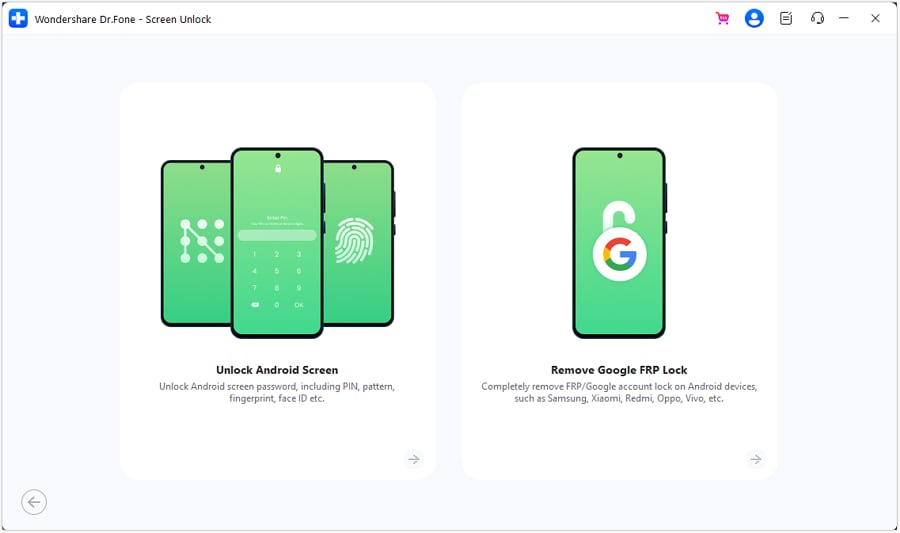
- Step 3: Select your device’s brand from the list and click Start to continue.
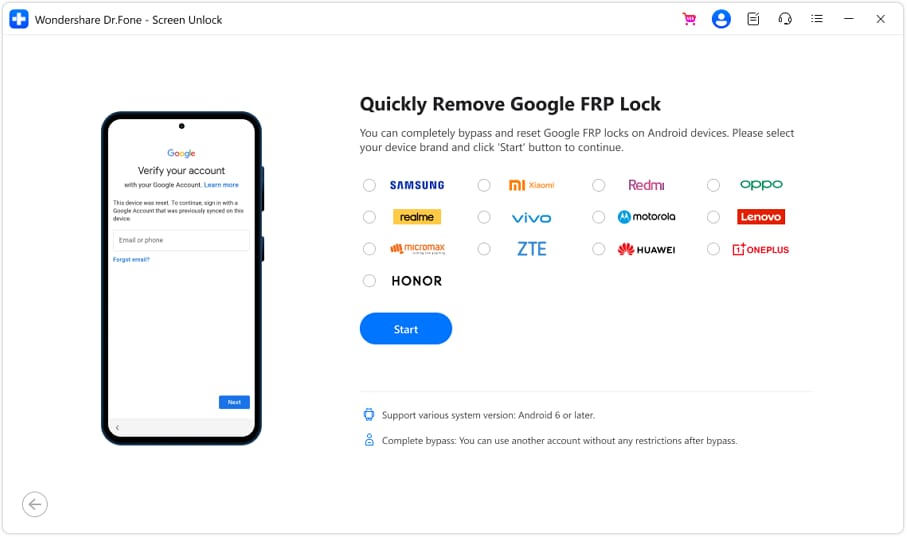
Note:
The next steps may vary depending on the brand you selected.
- Step 4: Select the OS version of your device and click Start to continue.
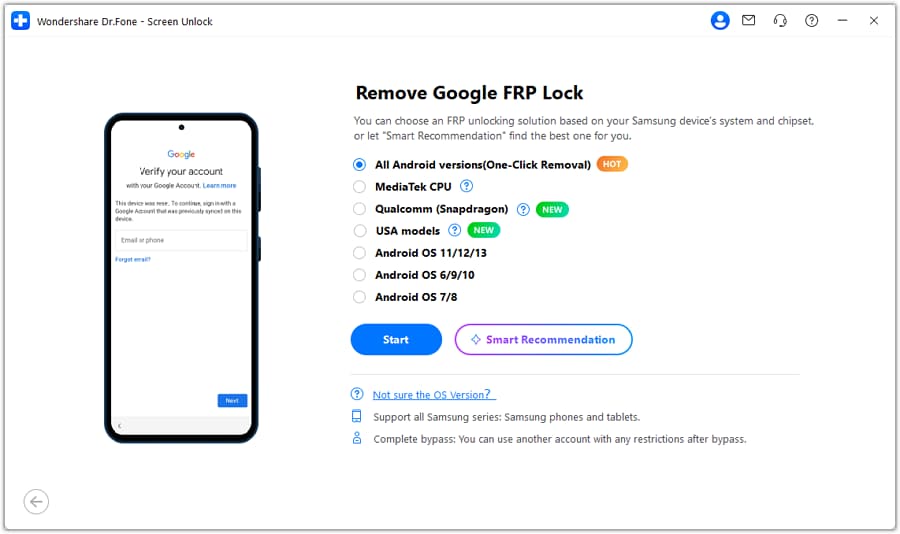
- Step 5: Access the secret menu on your phone using the on-screen instructions, then click Next to proceed to the next step.
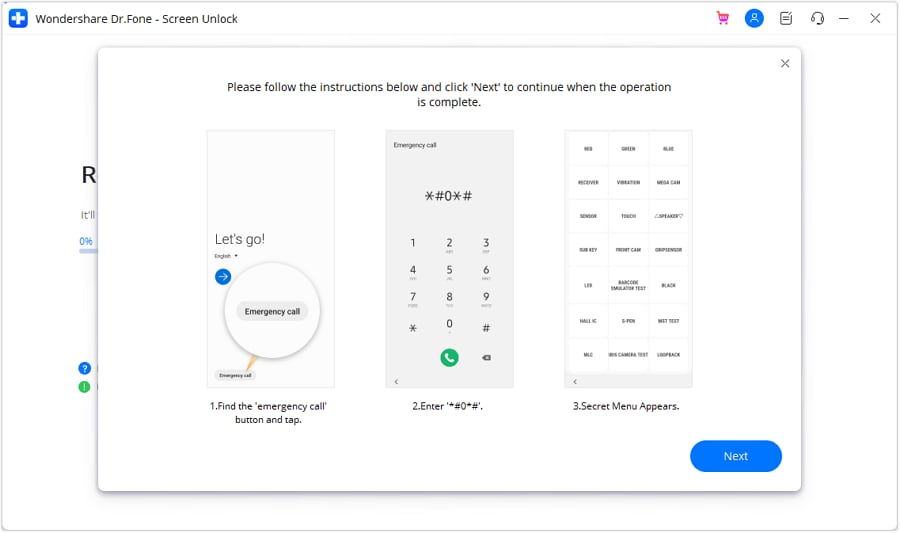
- Step 6: When your Samsung prompts you to activate USB debugging, tap Allow. Then, on your computer screen, click Authorized to confirm.

- Step 7: You will see the FRP lock being bypassed on your Android device on the next screen.
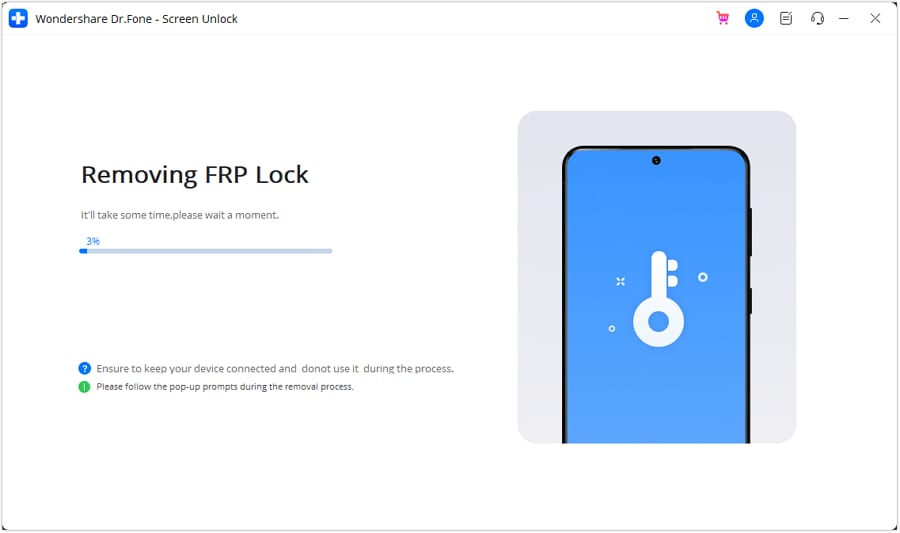
- Step 8: Click Done if the FRP lock removal was successful, otherwise, click Try Again to repeat the process.
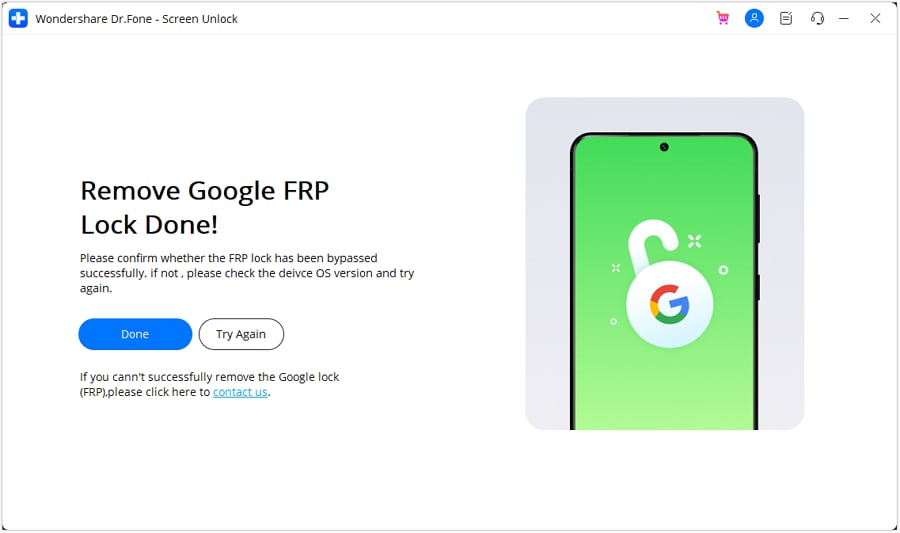
That’s it! With Dr.Fone Screen Unlock, you can easily bypass Google FRP and regain access to your Android device, leaving the complexities of RootJunky behind.
Tips: Are you searching for a powerful FRP bypass tool? No worries as Dr.Fone is here to help you. Download it and start a seamless unlock experience!
Conclusion
Both RootJunky and Dr.Fone offer options for you to regain control of phones with Google FRP lock. FRP Bypass RootJunky tool excels with its free-to-use approach, perfect for tech-savvy users comfortable with APK installations. While requiring a paid subscription, Dr. Fone provides pre-rooted firmware installations and broader device compatibility, which is ideal for those seeking a more streamlined but supported experience.
The best choice boils down to your personal needs and budget. Remember, FRP bypass should only be utilized by rightful owners facing genuine lockouts. When used responsibly, these tools can help you access your phone after a factory reset even without your Google account credentials. Choose the tool that best fits your needs and proceed with caution. Use these tools responsibly and regain access to your device the right way.
The Ultimate Guide: How to Bypass Swipe Screen to Unlock on Honor X50 GT Device
Nowadays, the security mode is enabled in almost all digital devices, which is the case with our smartphones. However, when we repeatedly change our password, we might be in a state of confusion to remember it. Such instances are highly schemed to lock our messages, galleries, emails, and other personal storage. Using the locking pattern enhances security, and thus, apart from the known user of the Honor X50 GT device, unknown people cannot access your Android phone. To overcome this critical situation, we have this article to help you unlock your Android devices by removing or bypassing the swipe lock Android screen. The solutions provided in this article are easily accessible to all users and are easy to operate.
So, if you have ever been stuck due to a lock code, go through the article to resolve the issue and swipe up to unlock a password that somehow gets forgotten.
Part 1: How to disable Swipe Screen to unlock when you can access the phone?
Some people do not pay much attention to their privacy and will not bother locking their Android devices. They would disable the swipe screen to unlock their devices. Thus, this section will talk about the basic solution to disabling the swipe up to unlock Android devices. Our main focus here is on a disabling method of swiping the screen when your Android device is accessible.
Let us look at the detailed steps below to remove the swipe screen to unlock the Android phone.
Step 1: To begin with, touch the gear icon (that is setting) on the main screen of your Android phone. The settings screen will display directly since it is a shortcut to get in. You will get a drop-down menu where you will see many options are available for your flexibility.
Step 2: Out of those, choose the “Security” tab to access your further.
Step 3: It will prompt the tab as “Screen security,” You will be listed with three choices, namely, Screen lock, Lock screen options, and Owner Information.
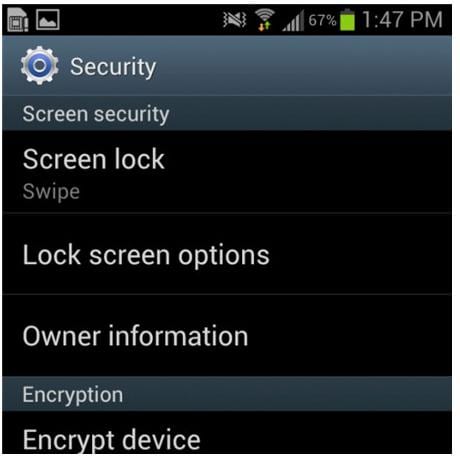
Step 4: Select the option called “Screen lock,” The next step is to enter your PIN code for security purposes. This step is carried out in Android phones to ensure you are the original owner of the Android device.
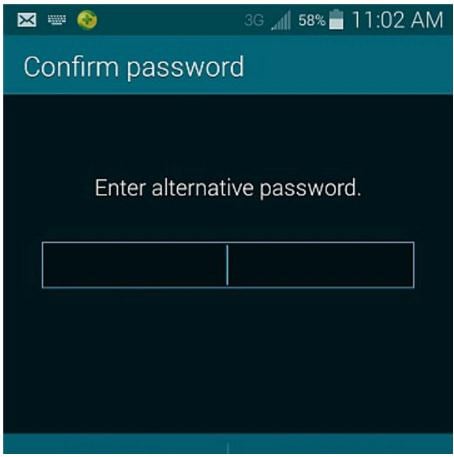
Step 5: If you click the PIN code option again, the drop-down menu will be listed with more options. Now select the option “None.”
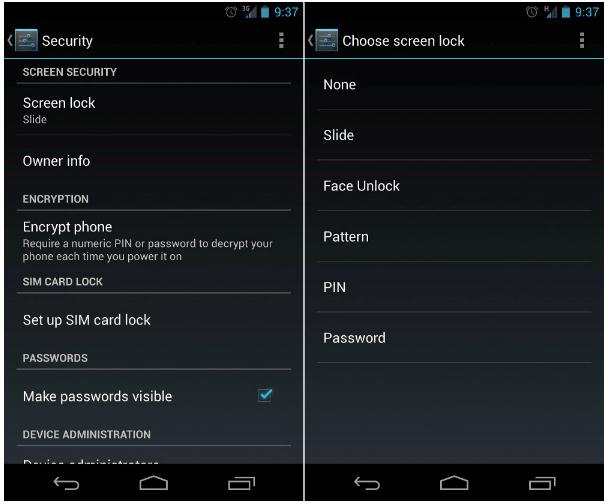
That’s all. You have successfully run out of the disable commands for the swipe up to unlock the screen. You can now open and access your device without any security methods.
Part 2:How to remove/bypass Swipe to unlock when the phone is locked?
To unlock your device, the only solution is to follow the Dr.Fone - Screen Unlock (Android) . If you are looking to unlock the screen when the phone is locked, then this method solidly proves to bypass swipe lock Android when it is locked. It helps to resolve this issue by bypassing or removing the swipe screen without causing any loss to your data. This tool temporarily supports bypassing Android screens without data loss on Samsung and LG. As for other Android phones, all the data will disappear after unlocking with this tool.
The features of this Dr.Fone software are many. It gives a solution to four lock methods: a pin, pattern, fingerprint, and password. It is user-friendly, and even a user with no technical information can also use it with no issue. This tool is only limited to remove the screen lock on Samsung and LG without losing data. Your data will still be wiped out on other Android phones after using this tool.
Dr.Fone - Screen Unlock (Android)
Remove 4 Types of Android Screen Lock without Data Loss
- It can remove four-screen lock types - pattern, PIN, password & fingerprints.
- Only remove the lock screen. No data loss at all.
- No tech knowledge asked. Everybody can handle it.
- Work for Samsung Galaxy S/Note/Tab series, and LG G2, G3, G4, etc.
4,008,669 people have downloaded it
Tips: This tool also supports unlocking other Android screens beyond Samsung and LG. However, it does not support saving all the data after unlocking, like Samsung and LG.
Step 1: Initialize the Dr.Fone on the computer, and there will be many options in front of you. In that, select the “Screen Unlock”.
Step 2: Now, to bypass swipe lock Android, using the USB cable, connect the Android device to your computer, and it will prompt the Unlock Android Screen option.

Step 3: To enable the download mode on your Android device, shut down your phone>Simultaneously, press the volume down, Home button, and Power button >Press the Volume up button. Once your device is in download mode, the recovery kit will get downloaded.
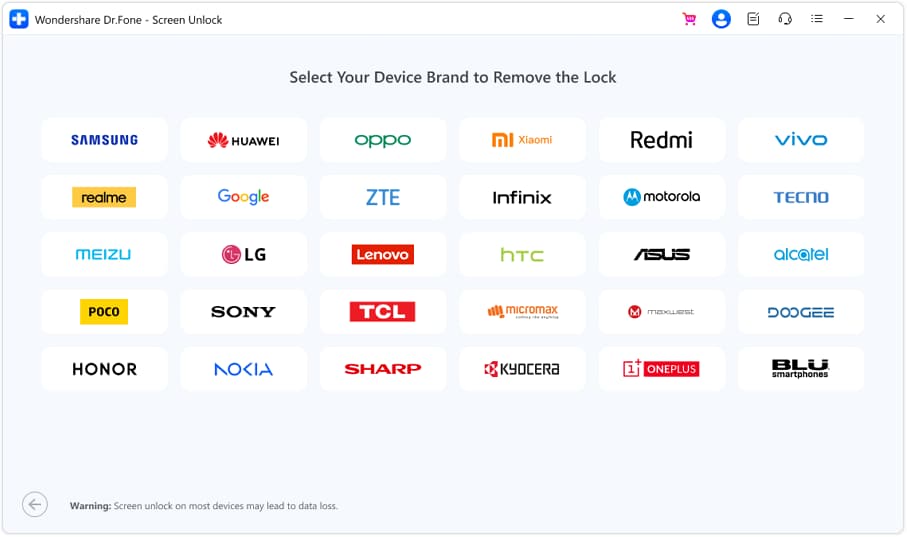
Step 4: You will see the result right in front of you as Dr.Fone - Screen Unlock, recovery will bypass swipe lock Android without hampering your data. Foremost, you can now access your device without swipe up to unlock the screen.
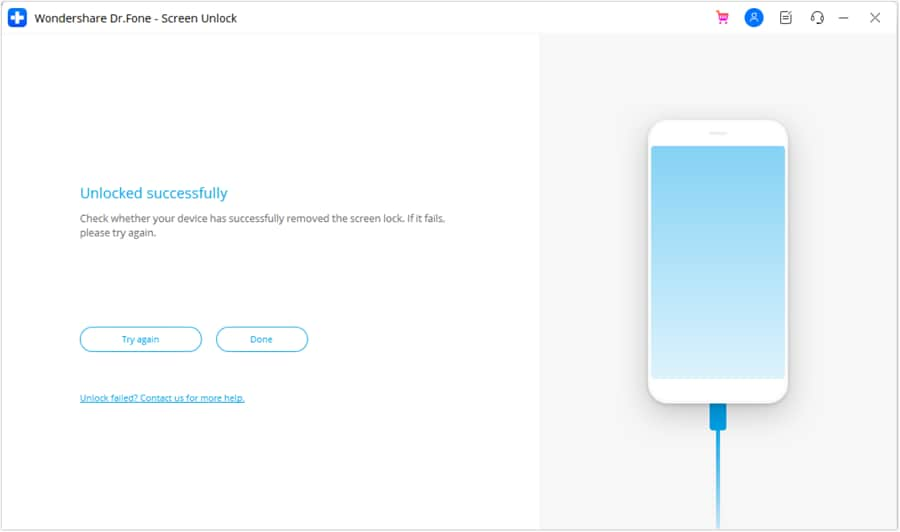
Pretty simple, right? Dr.Fone - Screen Unlock to the rescue for the issue of swipe screen to unlock.
Part 3: How to turn off the swipe to unlock when the pattern is enabled?
In this section, we will cover how to turn off the swipe to unlock when the pattern lock of the Honor X50 GT device is enabled. Therefore, here we will go through the process of turning off the swipe to unlock the feature of your device. This structure is formed in some interval of locking the screen.
The steps below imply turning off of swiping screen instantly:
Step 1: At first, open the app “Setting” present on your Android device.
Step 2: There will be multiple interfaces. Now choose the option “Security.”
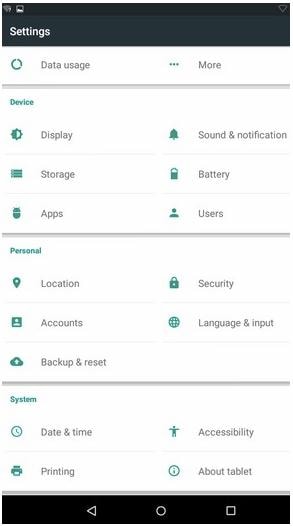
Step 3: To turn off the swipe screen, when the pattern is enabled then, choose “Screen lock” and then click on “NONE.”
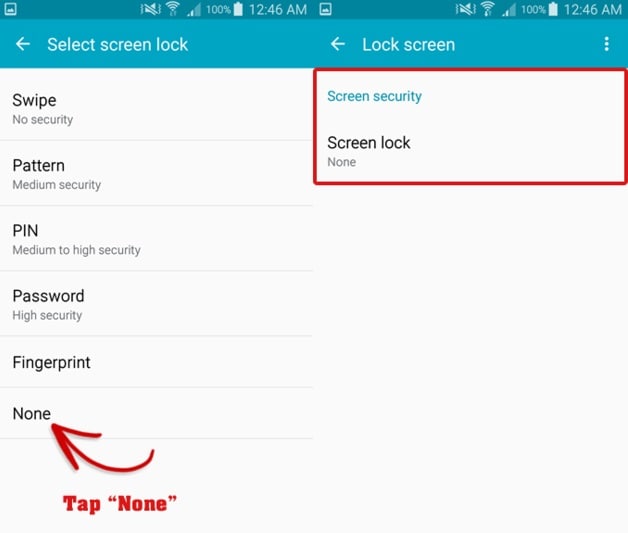
Step 4: If you have enabled your pattern choice already, it will again prompt you to enter the pattern. Once you entered the pattern, the swipe screen lock will disappear.
Step 5: The final step is to reboot your Android device to update the feature of turning off the swipe screen. Now you can open your device at any time without using the pattern lock feature.
Note: Regardless of any situation of forgetting the Android lock password, you can go for an email account set up for swiping into the Android devices.
Conclusion
Now, to sum up, we would say that in this article, we tried to bring out the best solutions for your Android device in such cases wherein you want to disable your screen security. The Dr.Fone - Screen Unlock is simply a proven mechanism that delivers what we need and that, too, without any data loss. We ensure that you can disable the swipe screen to unlock easily and effectively using the methods given above. Hence, you can access your phone by bypassing swipe lock Android even if you forget the screen lock code. So, don’t just wait, but bring out the solution for the swipe screen to unlock the Android device with Dr.Fone - Screen Unlock (Android) now.
How to Show Wi-Fi Password on Honor X50 GT
Since the invention of Android OS in 2008 by Andy Rubin, our world has faced a dramatic change. Android seems to be controlling a considerably high portion of our life. We have bought many gadgets that use this amazing OS and most of which are phones. But how much can you do with your Android phone? Developers are always making it more interesting to use this interface.
Most of the time, we use Android phones, we get faced with the need to access the internet. The Wi-Fi capability of these Android gadgets makes it super easy for us to surf the web. Throughout using Wi-Fi, we connect to a number of them. This could be at school, a sub-way café, the gym, buses, hospitals, hotels, towns, and the list is endless. A password secures most of this. Needless to say, our brain is weak to store all these passwords for future use, especially if you would want to connect with a different gadget you have recently bought or even your laptop. In this article, we will introduce you to how to find wifi password on rooted and also unrooted Android devices.
Part 1: Show Wifi Password on Rooted Android Device
What is Rooting?
First of all, what does rooting mean? You have probably used a Windows computer or even Linux. For the case of Windows, when installing a new program or software, it always prompts a dialog box saying, “Administrator permission required to run this program.” If you don’t have the administrator permission, you won’t install the program. In Android, this is called rooting. In simple terms, it means having the root permission to your phone. Some Android apps will require you the root permission, e.g., flashing your ROM. In this part, we will explain how you can show the Wi-Fi password on your Android with root.
To find the Wi-Fi passwords on your Android phone, you need to have an app to explore files which also supports a root user. In this case, ES FileExplorer or Root Explorer will come in handy. However, it turns out that the latter is offered at $3. Let’s use the free ES File Explorer.
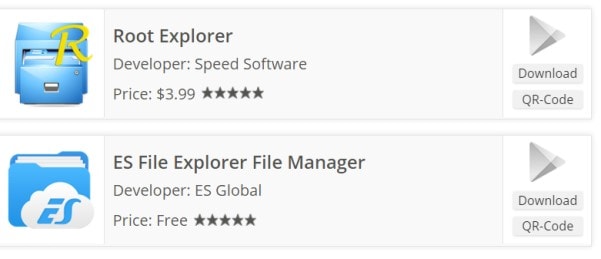
Steps of getting Wi-Fi password on Android with root
In only four steps, we, at this moment, learn how we can find the password of a Wi-Fi on an Android phone.
Step 1: Install the ES File Explorer
Download the ES File Explorer from your play store, install it, and open it.

Step 2: Enable Root Explorer
The root explorer needs to be enabled so that you can reach the root folders of the Wi-Fi passwords you need. By default, the root feature in this ES explorer is not enabled. To enable it, just tap on the list menu on the top left corner.:
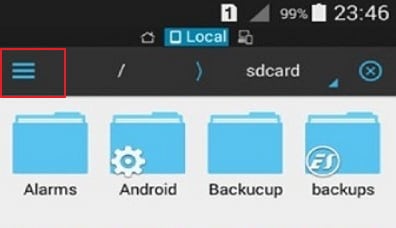
This will drop down a list of controls. Scroll down and find the Root Explorer option and enable it.
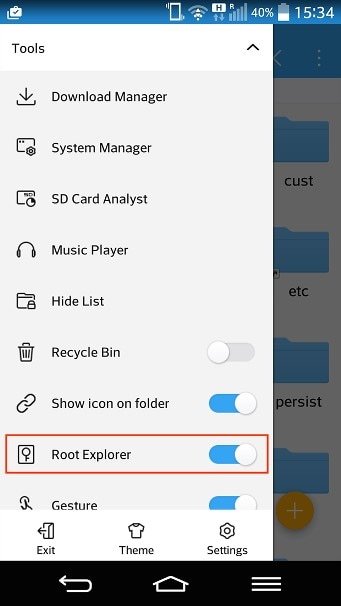
Step 3: Get the passwords’ file.
Go back to ES file explorer, and this time, find the folder named data.
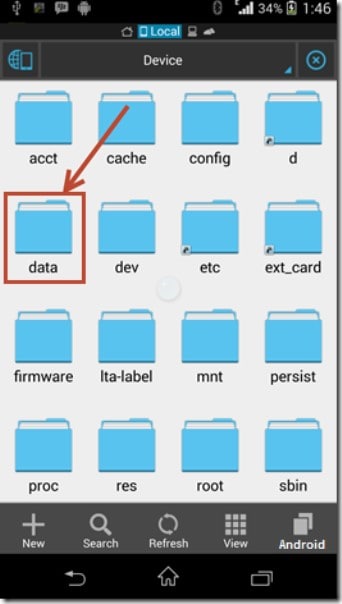
When this folder opens, find another one named misc. Open it and find another one named wifi. Here, find a file named wpa_supplicant.conf.

Step 4: Retrieve the wifi password on Android
Make sure that you don’t edit anything in the file. You might mess up with important data and fail to access the Wi-Fi(s) in the future.
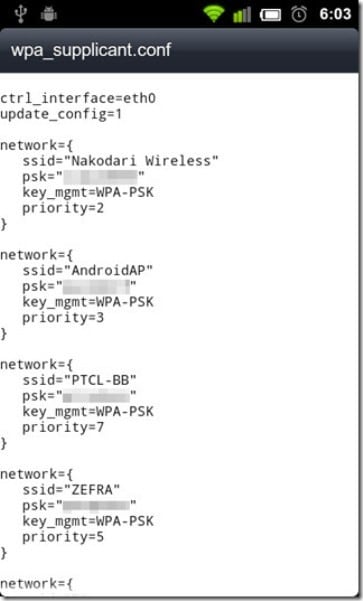
As you can see above, we have found the Wi-Fi passwords on the android device. On each network profile, we have the name of the network represented by name (ssid=”{the name}”), the network’s password represented by psk, the network’s access point represented by key_mgmt=WPA-PSK and its priority represented by priority.
Part 2: Show Wifi Password on Android without Root
What if I don’t have root access to my Android, can I still see Android Wi-Fi password? The short answer is yes. However, this is a bit involving but simple. You don’t need to be a computer guru to do it, but you need to have a computer and some internet access of course. The key thing is to find a way through which we can fetch the password file from the phone without using a root access protocol in the Android. This is made possible by some little programming insight using the Windows Command prompt.
Steps to show Wi-Fi password on Android without root
Step 1: Access the Developer authority
To access the files that Android uses to run passwords, you must first become a developer. This is very simple.
Get your Android phone and go to settings. Scroll down and find “About phone.” Tap on it and scroll down again to find Build number.

Tap on this “build number” 5 to 6 times until a message pops up, saying, “You are now a developer”.
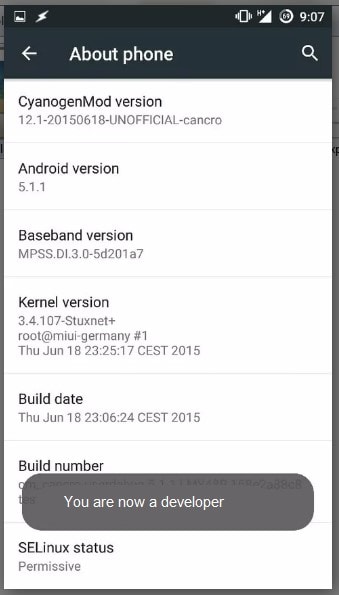
Step 2: Enable the debugging.
Go back to Settings. Scroll down for developer options. Turn on the button for “Android/USB debugging”.
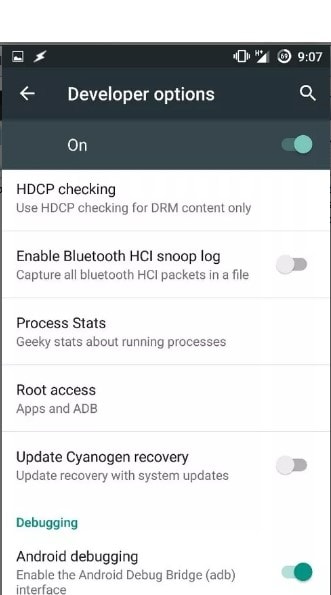
Step 3: Install ADB drivers.
Now, open your Windows desktop. Download and install ADB drivers. (Use this download link adbdriver.com ). You need to download and install platform tools (minimal ADB and fastboot) from http://forum.xda-developers.com/... Now open the folder where you’ve installed the above tools. By default, it is in the Local disc C\windows\system32\platform_tools location. However, you might want to locate them by searching on the windows search engine. You have to hold the Shift key and right-click inside the folder to click on”Open Command Window Here.”
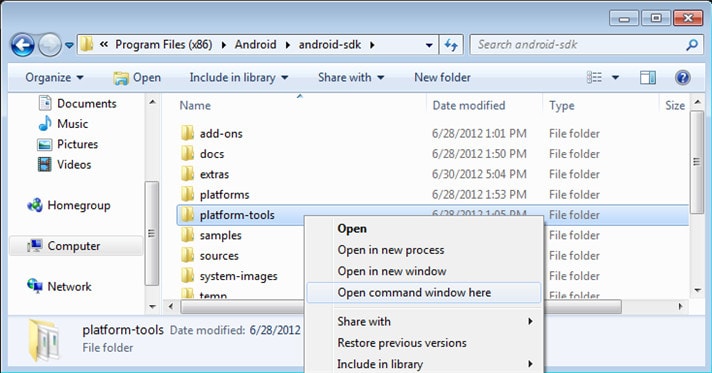
Step 4: Test the ADB
Here, we would like to test whether the ABD is working properly. To do this, connect your phone to the PC using a USB. In the command prompt, type adb services and then press enter. If it’s working properly, you should see a device on this list.

Step 5: Find the Android wifi password.
Now, it is time to type the given command in the command prompt and type: adb pull /data/misc/wifi/wpa_supplicant.conf c:/wpa_supplicant.conf. This will fetch the file from your phone to the local disc C drive of the PC.
Step 6: Get the wifi passwords.
Lastly, open the file with a notepad, and there you go.

Now you learned how to show the wifi password on your Android device.
Also read:
- [New] Mastering Your Digital Talk Leading Web-Based Text-to-Speech Apps for Chrome
- 2024 Approved Digital Broadcasting Platform Critique
- How to Bypass Android Lock Screen Using Emergency Call On Honor Magic 5 Pro?
- In 2024, How to Lock Apps on Itel P55T to Protect Your Individual Information
- In 2024, How to Use Google Assistant on Your Lock Screen Of Infinix Smart 8 HD Phone
- In 2024, Numeral 8 Innovative Image Fusion Application
- Lock Your Vivo S18 Phone in Style The Top 5 Gesture Lock Screen Apps
- Why does the pokemon go battle league not available On Lava Storm 5G | Dr.fone
- Windows 11対応: Samsung SSDから高性能な大容量SSDへ移行方法
- Title: In 2024, Rootjunky APK To Bypass Google FRP Lock For Honor X50 GT
- Author: Marry
- Created at : 2024-11-18 17:22:37
- Updated at : 2024-11-26 01:20:35
- Link: https://unlock-android.techidaily.com/in-2024-rootjunky-apk-to-bypass-google-frp-lock-for-honor-x50-gt-by-drfone-android/
- License: This work is licensed under CC BY-NC-SA 4.0.